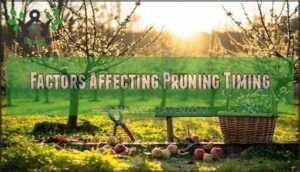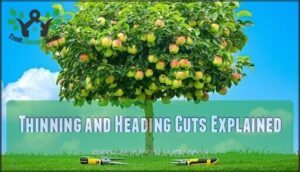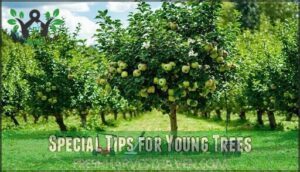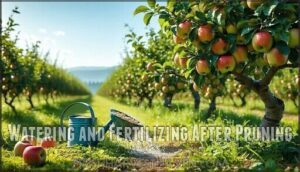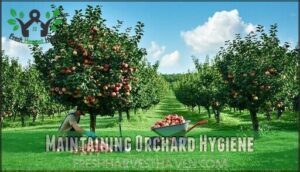This site is supported by our readers. We may earn a commission, at no cost to you, if you purchase through links.
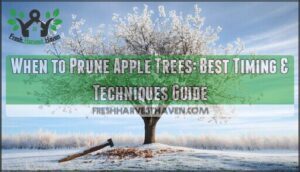
This timing lets the tree heal faster while you can easily see the branch structure without leaves getting in your way.
Avoid pruning once buds start swelling, as this stresses the tree and can reduce fruit production.
Cold-climate gardeners should wait until the worst frost risk passes.
Young trees need gentler pruning than mature ones, and different apple varieties require specific approaches.
The right timing makes all the difference between a thriving orchard and struggling trees that produce disappointing harvests.
Table Of Contents
- Key Takeaways
- Why Prune Apple Trees?
- When to Prune Apple Trees for Best Results
- Factors Affecting Pruning Timing
- Summer Vs. Winter Pruning
- Choosing The Right Pruning Tools
- Step-by-Step Pruning Techniques
- Pruning for Better Fruit Production
- Post-Pruning Care and Maintenance
- Frequently Asked Questions (FAQs)
- What is the best month to prune apple trees?
- What is the 123 rule of pruning?
- What not to do when pruning apple trees?
- What branches to cut when pruning apple trees?
- How often should mature apple trees be pruned?
- Can you prune apple trees in summer months?
- What happens if you skip pruning for years?
- Should different apple varieties be pruned differently?
- How does tree age affect pruning requirements?
- Can you prune apple trees in hot summer weather?
- Conclusion
Key Takeaways
- Prune during late winter or early spring – You’ll get the best results when trees are dormant, typically February through early March, before buds start swelling.
- Wait until the worst frost passes – You should avoid pruning during the coldest weather to prevent cold damage, but finish before active growth begins.
- Age matters for your approach – You’ll need gentler pruning on young trees versus mature ones, with newly planted trees requiring minimal cuts the first year.
- Clean tools prevent disease spread – You must disinfect your pruning shears between cuts and trees to avoid spreading infections like fire blight throughout your orchard.
Why Prune Apple Trees?
Pruning your apple trees isn’t just about keeping them tidy—it’s essential for their health and your harvest.
Regular pruning removes diseased wood, improves air circulation, controls tree size, and directs energy toward producing bigger, better fruit.
Health and Longevity Benefits
Regular apple tree pruning transforms weak, struggling trees into robust specimens that can thrive for decades.
Transform your struggling apple trees into decades of thriving fruit production with strategic pruning cuts
You’re basically giving your tree a health checkup, removing diseased wood before problems spread throughout the canopy.
This preventive care strengthens branch health and supports proper root development, creating the foundation for long-term tree longevity and consistently high fruit quality, which is crucial for long-term tree success.
Improved Fruit Production
Proper pruning cuts directly boost your fruit yield by redirecting the tree’s energy toward productive branches.
When you prune apple trees during the dormant season, you’re basically telling your tree where to focus its resources.
Strategic tree training through selective pruning cuts improves fruit quality by allowing better sunlight penetration and air circulation.
This targeted approach enhances harvest timing consistency and maximizes your apple tree’s productive potential.
Controlling Size and Shape
Pruning apple trees gives you complete size control and crown management over your orchard.
Tree shaping through strategic branch thinning keeps trees at manageable heights for easier harvesting. You’ll control where energy goes—directing growth outward rather than skyward.
Proper prune timing with these tree pruning techniques prevents overcrowding while maintaining your desired form and accessibility.
Disease and Pest Prevention
Thinning overcrowded branches creates better airflow, reducing fungal diseases that thrive in humid conditions.
When you prune apple trees strategically, you’re building natural disease resistance through improved circulation and sunlight penetration.
Essential disease prevention through apple tree pruning:
- Fungal Control – Remove overlapping branches to eliminate moisture pockets
- Sanitation Methods – Cut diseased wood 6 inches below infection points
- Pest Management – Eliminate hiding spots for overwintering insects
- Insect Prevention – Open canopies discourage aphid and mite infestations
- Disease Resistance – Promote healthy wood growth through proper tree pruning tips
Understanding disease prevention methods is vital for maintaining healthy apple trees.
When to Prune Apple Trees for Best Results
Timing your apple tree pruning correctly can make the difference between a bountiful harvest and a disappointing season.
The best time to prune apple trees is during late winter or early spring when the tree remains dormant.
This apple pruning season typically spans from February through early March, though you’ll want to finish before buds begin to swell.
Pruning schedules should align with tree dormancy because cuts heal faster when energy flows toward root development rather than leaf production.
When you prune apple trees during this window, you’re setting up ideal conditions for fruit yield improvements.
The dormant period offers several advantages: you can easily spot structural issues without leaves blocking your view, and the tree won’t experience stress from active growth.
Understanding proper pruning techniques is vital for maximizing fruit production and maintaining tree health.
| Season | Benefits | Risks |
|---|---|---|
| Late Winter | Fast healing, easy branch visibility | Cold damage to fresh cuts |
| Early Spring | Ideal timing, promotes growth | May interfere with flowering |
| Summer | Controls vigor, manages disease | Reduces next year’s fruit production |
| Fall/Early Winter | None recommended | Exposes cuts to harsh weather |
These pruning methods work best when you avoid rainy conditions to prevent disease transmission.
Factors Affecting Pruning Timing
While late winter remains the gold standard for apple tree pruning, several key factors can shift your timing window and affect your success.
Your tree’s age, local weather patterns, and specific apple variety all play vital roles in determining when those pruning shears should come out of storage.
Tree Age Considerations
Age plays a vital role when you prune apple trees.
Different growth stages require unique approaches for effective results. Young trees need gentle shaping while mature trees can handle more aggressive cuts.
Here’s how tree age affects your pruning strategy:
- Newly planted trees – Cut whips to 30 inches immediately after planting for strong framework development
- Young trees (1-5 years) – Light annual pruning focusing on sapling pruning and structure building
- Mature tree (6-25 years) – Moderate to vigorous pruning for wood renewal and height control
- Aging tree maintenance (25+ years) – Intensive rejuvenation spread over multiple seasons
Understanding proper tree pruning techniques is essential for healthy tree development.
Local Climate and Weather
Your local climate conditions determine the sweet spot for winter pruning success.
In Climate Zones 3-5, wait until late winter when Temperature Fluctuations stabilize but before early spring growth begins.
Regional Variations matter—southern areas can start earlier, while northern regions need patience until Frost Timing passes.
Weather Patterns like unexpected warm spells can trick trees into breaking dormancy early, so monitor conditions closely during the dormant season.
Tree Variety and Growth Patterns
Different apple tree varieties require customized pruning approaches based on their unique growth patterns.
Dwarf trees need lighter cuts than vigorous varieties like ‘Granny Smith.’
Spur-bearing types concentrate fruit on short branches, while tip-bearers fruit at shoot ends—excessive pruning reduces their yield.
Columnar varieties require minimal thinning, and biennial bearers like ‘Honeycrisp‘ need strategic off-year pruning for consistent harvests.
Summer Vs. Winter Pruning
The timing debate between summer and winter pruning isn’t just academic—it directly impacts your apple tree’s health and fruit production.
Understanding when to use each approach will help you maximize your harvest while keeping your trees thriving year after year, which is crucial for maintaining their overall production.
Dormant Season Pruning Benefits
When winter arrives with its dormant embrace, your apple tree enters its most cooperative pruning phase.
Winter pruning during the dormant season delivers unmatched benefits that’ll transform your orchard management.
| Benefit | Winter Advantage | Impact |
|---|---|---|
| Tree Renewal | 35% more fruiting wood | Enhanced productivity |
| Frost Protection | 90% less wound damage | Safer healing |
| Seasonal Growth | Controlled vigor response | Better structure |
Dormant care reduces tree stress substantially compared to active growing periods.
You’ll notice faster wound healing in cool conditions, with callus formation completing within 3-5 weeks.
This timing prevents premature growth that late frosts could damage, while disease transmission drops below 8% – a stark contrast to summer’s 27% infection rates, showcasing the importance of winter pruning and dormant care for tree renewal and overall orchard health.
Summer Maintenance Tips
While dormant season pruning handles major structural work, summer pruning focuses on fine-tuning your apple tree’s health.
You’ll want to remove water sprouts and suckers that drain energy from fruit production.
Light trimming also improves air circulation around developing apples.
| Summer Task | Timing | Purpose |
|---|---|---|
| Remove water sprouts | June-July | Redirect energy to fruit |
| Thin overcrowded branches | Early summer | Improve air flow |
| Monitor pest activity | Weekly checks | Early intervention |
| Maintain soil moisture | Consistent watering | Support fruit development |
| Prune diseased foliage | As needed | Prevent spread |
Summer pruning keeps your tree pruning schedule balanced throughout the growing season.
Focus on light maintenance rather than heavy cutting when you prune apple trees during warm months.
Risks of Fall and Early Winter Pruning
Pruning apple trees during fall and early winter substantially increases cold damage and frost risk.
Your trees become vulnerable to winter injury within 48 hours after cutting, with sensitivity lasting up to two weeks. Fresh wounds heal slowly in cold weather, creating entry points for disease spread and fungal infections.
To avoid these issues, consider the benefits of proper winter pruning techniques for maintaining healthy trees.
| Risk Category | Specific Impact |
|---|---|
| Cold Damage | Reduces cold tolerance, causes frost cracks |
| Disease Spread | Slow-healing wounds invite fungal pathogens |
| Reduced Fruit | Removes next season’s flower buds |
| Poor Healing | Wounds stay open for months |
| Tree Vigor | Interrupts energy storage for spring growth |
Understanding proper apple tree pruning timing prevents these costly mistakes that can damage your orchard for years.
Choosing The Right Pruning Tools
You’ll need the right tools to make clean, precise cuts that heal properly and prevent disease transmission.
Having sharp, well-maintained equipment and proper safety gear makes pruning safer and more effective for both you and your apple trees.
Essential Pruning Equipment
Having the right tools makes all the difference between a frustrating hack job and smooth, professional cuts.
You’ll need four essential pieces to tackle any apple tree with confidence:
- Pruning Shears – Your go-to for branches under ¾ inch
- Loppers – Handle those stubborn ¾ to 1½ inch branches
- Pruning Saw – Conquers anything over 1½ inches
- Gardening Gloves – Protect your hands from thorns and rough bark
Don’t forget safety glasses and a reliable sharpener to keep saw blades razor-sharp throughout the season.
Investing in high-quality pruning shear sets can substantially improve your pruning experience.
Tool Cleaning and Maintenance
Clean pruning shears between each cut using disinfectant to prevent spreading disease between branches.
Sharp blades make cleaner cuts that heal faster, so keep sharpener tips handy for touch-ups.
After each session, remove sap and debris with cleaning solutions, then apply rust prevention oil.
Store gardening tools in dry conditions.
A well-maintained pruning saw cuts like butter through thick branches.
Proper pruning techniques involve using high-quality pruning shear tools to achieve the best results, with sharp blades and cleaner cuts.
Safety Gear and Preparation
Before you climb that ladder with sharp pruning shears in hand, proper safety preparation can mean the difference between a successful pruning session and an emergency room visit.
- Pruning Gloves: Wear thick leather or rubber gloves to protect hands from cuts and thorns
- Safety Goggles: Shield your eyes from flying debris and sharp branches during cutting
- Protective Clothing: Choose long sleeves and sturdy pants to guard against scratches
- Clean Equipment: Sanitize all pruning shears and tree pruning tools with rubbing alcohol before use
Understanding tree pruning basics is essential for a successful pruning session.
Step-by-Step Pruning Techniques
Now that you’ve got your tools ready, it’s time to put them to work with proven pruning techniques that’ll transform your apple tree’s health and productivity.
These step-by-step methods will guide you through removing problematic wood, making strategic cuts, and shaping your tree for years of abundant harvests.
Removing Dead and Diseased Wood
Dead-wood detection requires your trained eye to spot trouble before it spreads throughout your apple tree. Look for branches with peeling bark, hollow sections, or brittle wood that snaps easily when bent.
| Issue Type | Visual Signs | Action Required |
|---|---|---|
| Dead Branches | Brown/gray bark, no buds, brittle texture | Remove completely at collar |
| Diseased Wood | Cankers, discoloration, oozing sap | Cut 6" below symptoms |
| Damaged Areas | Split bark, broken limbs, pest holes | Clean cut to healthy tissue |
| Crossing Branches | Rubbing wounds, bark damage | Remove weaker branch |
Make your pruning cuts clean and decisive—ragged wounds invite more problems than they solve. Proper pruning tools like pruning saws are essential for effective tree maintenance.
Thinning and Heading Cuts Explained
After removing dead wood, you’ll focus on two fundamental pruning techniques that shape your tree’s future growth.
Understanding thinning cuts and heading cuts helps you prune apple trees effectively, directing energy where it’s needed most.
- Thinning cuts remove entire branches back to their origin point, opening up the canopy for better light penetration
- Heading cuts trim branches back to a bud or lateral branch, encouraging dense new growth below the cut
- Branch removal through thinning reduces overcrowding while heading cuts control length and stimulate branching
- Pruning tools like sharp bypass pruners work best for clean cuts that heal quickly and prevent disease entry
Shaping for Better Growth
Once you’ve mastered thinning and heading cuts, focus on your tree’s overall architecture.
Proper tree structure creates the framework for healthy growth patterns and maximum fruit production through strategic crown shaping.
| Growth Goal | Pruning Approach |
|---|---|
| Open Center | Remove central leader, encourage 3-4 main scaffolds |
| Modified Leader | Maintain central trunk with balanced side branches |
| Espalier Training |
Guide branches horizontally along support structures.
Branch angle management plays a key role in shaping success.
Aim for 45-60 degree angles from the trunk when pruning apple trees.
This sweet spot promotes strong branch attachment while encouraging fruit production over excessive vegetative growth.
Special Tips for Young Trees
During their formative years, young apple trees need gentle guidance rather than heavy-handed pruning. Focus on establishing good structure while allowing natural growth patterns to develop through careful sapling management.
- Start light pruning schedules after planting – Wait until the second year before making significant cuts to avoid shocking newly transplanted saplings.
- Train the central leader early – Select one strong vertical shoot as your main trunk and remove competing leaders to establish proper tree training from the start.
- Remove only damaged or crossing branches – Keep pruning minimal on young trees, focusing on obvious problems rather than aggressive shaping during nursery tips development.
- Shape gradually over several seasons – Spread major structural work across multiple years rather than attempting dramatic changes in one pruning session when you prune apple trees.
- Encourage scaffold branch development – Select 3-4 well-spaced branches at different heights to form your tree’s main framework, following proven apple tree pruning tips for long-term success.
Pruning for Better Fruit Production
Strategic pruning transforms your apple tree from a simple grower into a productive fruit machine.
You’ll maximize both fruit quality and quantity by targeting specific branches that encourage healthy fruiting wood development.
Encouraging Fruiting Wood
To maximize fruit production, you’ll prune apple trees by thinning older branches and encouraging fruiting spurs.
Focus your cuts on wood two years or older, where 80-90% of fruit develops.
Strategic branch thinning opens the canopy for sunlight penetration, essential for productive fruiting wood.
| Pruning Technique | Target Area | Expected Result |
|---|---|---|
| Thinning cuts | Entire limbs | Flower bud development |
| Spur renewal | 2+ year wood | New fruiting spurs |
| Canopy opening | Dense branches | Light penetration |
The goal is to apply these techniques effectively to enhance the tree’s productivity, focusing on complete concepts such as branch thinning and spur renewal to improve overall fruit production.
Promoting Cross-Pollination
Cross-pollination success hinges on smart pruning techniques that encourage bee visits and pollen transfer between apple varieties.
When you prune apple trees strategically, you’ll create the perfect environment for maximum fruit set.
Here are five key pruning strategies for better cross pollination:
- Open canopy structure – Remove dense interior branches so bees can easily navigate between flowers
- Stagger bloom times – Prune different varieties at slightly different intensities to extend pollination windows
- Create pollinator highways – Maintain clear flight paths between compatible apple tree varieties in your orchard
- Preserve flowering spurs – Keep short, stubby branches that produce the most blossoms for maximum pollen transfer
- Position compatible varieties – Plant and shape trees so cross-pollinating varieties are within 50 feet of each other
Proper fruit tree pruning transforms your orchard into a bee-friendly zone, boosting pollination methods and ensuring reliable fruit production through effective apple tree care.
Increasing Fruit Yield and Quality
Strategic fruit enhancement starts with precise tree balancing through targeted cuts.
When you prune apple trees during dormancy, you’re optimizing yield by removing excess flower buds – about one-third helps achieve larger, sweeter apples.
This growth regulation directs energy into fewer, higher-quality fruits rather than many small ones, which is crucial for proper harvest timing that depends on this winter preparation for maximum results, involving precise tree balancing and targeted cuts.
Post-Pruning Care and Maintenance
Proper care after pruning guarantees your apple tree recovers quickly and channels energy into healthy new growth and fruit development.
You’ll need to monitor watering needs, watch for signs of stress or disease, and maintain clean orchard conditions to maximize your pruning efforts and ensure quickly recovery.
Watering and Fertilizing After Pruning
Water your apple tree maintenance properly after pruning to support recovery and growth.
Post prune care requires balancing soil moisture with proper fertilizer types to establish healthy nutrient balance.
Essential water scheduling and fertilization tips:
- Deep watering weekly – Soak root zones thoroughly rather than frequent shallow drinks
- Balanced fertilizer application – Apply 10-10-10 fertilizer around drip line in early spring
- Monitor soil moisture levels – Check 2-3 inches deep; soil should feel like wrung-out sponge
- Avoid nitrogen overload – Too much promotes leafy growth over fruit production
- Mulch retention – Maintain 3-inch organic mulch layer for consistent moisture
Monitoring for Disease or Stress
After pruning apple trees, watch for early Disease Signs like wilting leaves, unusual discoloration, or oozing sap that indicate Fungal Infections.
Regular Tree Inspection helps identify Stress Factors such as pest activity or nutrient deficiencies before they compromise tree health and orchard management success.
Understanding proper fruit tree pruning techniques is essential for maintaining healthy trees and preventing disease spread.
| Disease Signs | Stress Factors | Action Required |
|---|---|---|
| Leaf spots/wilting | Pest damage | Apply targeted treatment |
| Bark discoloration | Poor drainage | Improve soil conditions |
| Unusual growth | Nutrient deficiency | Adjust fertilization |
Maintaining Orchard Hygiene
Beyond watching for disease signs, proper sanitation methods form your orchard’s first line of defense.
Clean pruning debris immediately after cutting to eliminate hiding spots for pests and pathogens.
Here’s your hygiene checklist:
- Remove all fallen branches – They’re disease breeding grounds waiting to strike
- Disinfect tools between trees – One infected cut can doom your entire orchard
- Clear weeds around tree bases – These harbor insects that love apple tree bark
- Dispose of debris off-site – Composting diseased material spreads problems
Frequently Asked Questions (FAQs)
What is the best month to prune apple trees?
February through early March offers the sweet spot for apple tree pruning.
You’ll catch them during dormancy when cuts heal quickly and energy focuses on root development.
Wait until the coldest weather passes, but finish before buds swell.
What is the 123 rule of pruning?
Like mastering any craft, the 123 rule provides your roadmap to pruning success.
You’ll remove branches growing downward first, then inward-facing ones, finally upward competitors.
This systematic approach guarantees proper light penetration and airflow throughout your tree.
What not to do when pruning apple trees?
Avoid pruning during wet weather, which spreads disease like fire blight.
Don’t cut flush to the trunk or leave long stubs.
Never prune heavily stressed trees or remove more than 25% annually.
What branches to cut when pruning apple trees?
Dead wood whispers danger—you’ll cut diseased, damaged, and crossing branches first. Remove water sprouts, suckers, and inward-growing limbs. Target weak crotches and overcrowded areas to let sunlight dance through.
How often should mature apple trees be pruned?
You should prune mature apple trees annually during late winter or early spring while they’re dormant.
This consistent yearly schedule maintains tree health, maximizes fruit production, and prevents overgrowth from getting out of hand, which is crucial for maximizes fruit production.
Can you prune apple trees in summer months?
While winter dormancy is ideal, you can prune apple trees during summer months for specific purposes.
Summer pruning works well for controlling vigorous growth, improving light penetration, and managing tree size without stimulating excessive new shoots, which is useful for summer pruning.
What happens if you skip pruning for years?
Skipping years of pruning creates an overgrown, unproductive mess.
You’ll face dense branches blocking sunlight, weakened limbs prone to breaking, poor fruit quality, and disease-prone conditions that’ll require aggressive corrective pruning later.
Should different apple varieties be pruned differently?
Like pruning different instruments in an orchestra, each apple variety needs its own tuning.
Dwarf trees require lighter touches, while standard varieties handle heavier cuts.
Spur-bearing and tip-bearing apples demand distinct approaches for maximum fruit production.
How does tree age affect pruning requirements?
Young trees need aggressive pruning to establish strong structure, while mature trees require lighter maintenance cuts.
You’ll prune heavily during the first three years, then shift to annual shaping and deadwood removal as your tree reaches full production.
Can you prune apple trees in hot summer weather?
Summer pruning isn’t ideal—you’ll stress your tree when it’s already working hard in the heat.
Hot weather slows healing and invites disease through fresh cuts.
Save major pruning for late winter dormancy when your apple tree can bounce back stronger, as this allows it to recover from the pruning more effectively.
Conclusion
Like a master gardener tending their prize roses, knowing when to prune apple trees transforms your orchard from chaotic wilderness into productive paradise.
Late winter dormancy offers the perfect window—typically February through early March—when trees can heal efficiently without leaf interference.
You’ll maximize fruit production while maintaining tree health by timing cuts precisely, and remember that young trees need gentler approaches than mature specimens.
Local climate affects your pruning schedule, so master this timing, and you’ll enjoy abundant harvests for years ahead.
- https://yardandgarden.extension.iastate.edu/how-to/how-prune-and-train-young-apple-trees
- https://www.oksir.org/backyard-tree-care/pruning/
- https://www.hausandgarten.com/blogs/learn/common-mistakes-you-should-avoid-when-pruning-apple-trees
- https://extension.okstate.edu/fact-sheets/annual-pruning-of-fruit-trees.html
- https://extension.illinois.edu/fruit-trees/making-pruning-cuts


